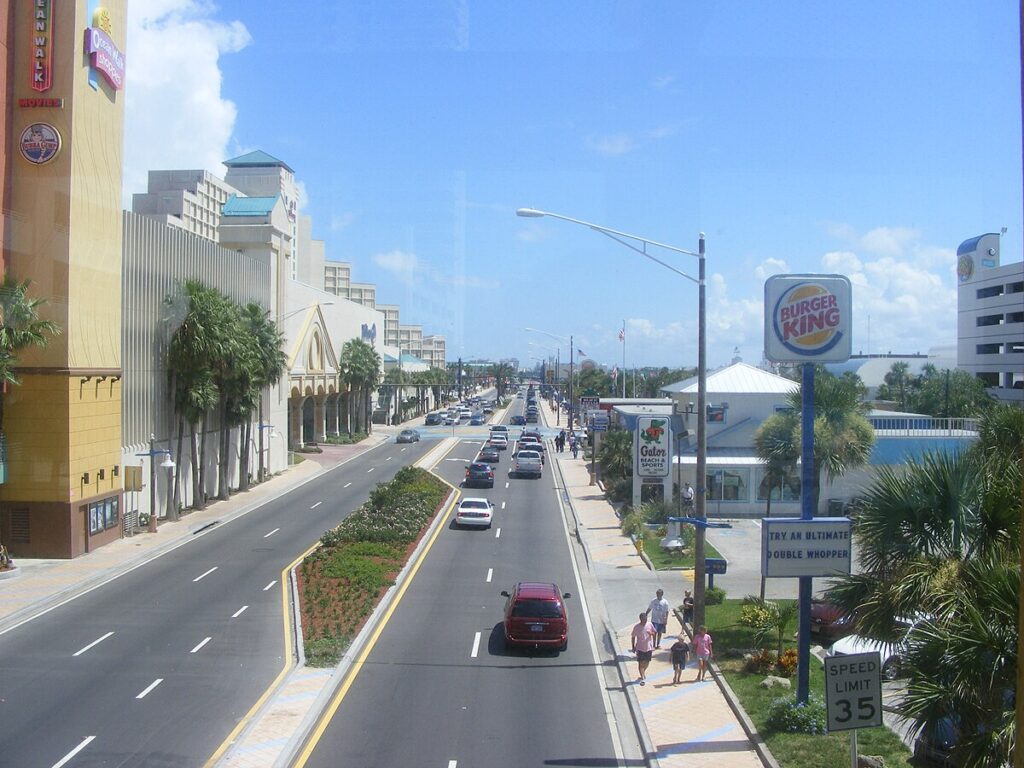
Moving to Daytona Beach, Florida: A Comprehensive Relocation Guide
Considering moving to Daytona Beach, Florida? This iconic Atlantic Coast city offers world-famous beaches, motorsports heritage, and affordable coastal living. With approximately 89,000 residents in 2025, Daytona Beach combines beach town atmosphere with cultural attractions and convenient Central Florida location.
Demographic Profile to Consider If Moving to Daytona Beach:
Daytona Beach’s 2025 population stands at approximately 89,000 residents, showing significant growth from 72,000 in 2020. The median age is 39.8 years, reflecting a mix of families, young professionals, college students, and retirees. The population is approximately 54% White, 32% Black or African American, and includes diverse residents. The city stretches along the Atlantic Ocean in Volusia County, with neighborhoods ranging from historic downtown areas to beachfront properties and suburban developments. Daytona Beach is famous for its hard-packed sand allowing vehicles on certain beach sections, creating a unique driving-on-the-beach tradition. The city serves as the “World Center of Racing” and headquarters of NASCAR. Find trusted local services for moving, living, and working in Daytona Beach.Daytona Beach Relocation Directory
Cost of Living to Consider If Moving to Daytona Beach:
Daytona Beach offers exceptional affordability for an Atlantic Coast beach community. Median home values range from $250,000 to $350,000 in 2025, with beachfront properties commanding premiums but remaining accessible compared to other Florida beaches. The median household income is approximately $50,000. Rental properties average $1,400 to $1,800 monthly. Florida’s lack of state income tax benefits residents. Overall cost of living is moderate, making Daytona Beach attractive for retirees, first-time buyers, and those seeking beach lifestyle without premium pricing. The city provides value for Atlantic Ocean access while remaining more affordable than South Florida or Space Coast alternatives. This affordability drives continued population growth.
Economy and Job Market:
Daytona Beach’s economy centers on tourism, motorsports, education, and healthcare. Tourism drives significant employment with over 8 million annual visitors to beaches, Daytona International Speedway, and special events. NASCAR headquarters and the speedway employ hundreds directly and support extensive motorsports-related businesses. Major employers include Halifax Health hospital system, Embry-Riddle Aeronautical University, Daytona State College, and Volusia County Schools. The aviation sector thrives with multiple flight schools. Retail and hospitality sectors support the tourism economy. Many residents work in service industries, healthcare, and education. The broader Deltona-Daytona Beach-Ormond Beach metro area offers additional employment opportunities. Seasonal tourism creates fluctuating employment patterns.
Education:
Volusia County Schools serves Daytona Beach students, operating numerous schools including Seabreeze High School, Mainland High School, and various elementary and middle schools throughout the city. The district serves the entire county with diverse program offerings. Embry-Riddle Aeronautical University in Daytona Beach is a world-renowned aviation and aerospace university attracting students globally. Daytona State College provides associate degrees, bachelor’s programs, and workforce training. Bethune-Cookman University, a historically Black university, offers four-year degrees. The concentration of higher education institutions creates an academic presence and provides residents with educational access.
Recreation and Lifestyle:
Daytona Beach’s 23 miles of hard-packed sand beaches define the recreational landscape, with vehicle access creating unique beach experiences. The Daytona Beach Boardwalk and Pier offer classic seaside amusement. Daytona International Speedway hosts NASCAR’s Daytona 500, Coke Zero Sugar 400, and the 24 Hours of Daytona, attracting motorsports enthusiasts worldwide. Bike Week and Biketoberfest bring hundreds of thousands of motorcyclists. The Museum of Arts and Sciences provides cultural programming. Parks, golf courses, and water sports serve residents year-round. The Halifax River offers boating and fishing. Ponce Inlet Lighthouse and nearby attractions complement beach activities. The subtropical climate enables outdoor recreation throughout the year. The city’s motorsports heritage and beach culture create a distinctive lifestyle.
Healthcare and Services:
Halifax Health dominates healthcare in Daytona Beach, operating Halifax Hospital Medical Center and multiple facilities throughout Volusia County. The hospital district provides comprehensive services including emergency care, trauma center, cardiac care, and specialized treatments. AdventHealth and other providers operate facilities in the region. Numerous medical offices, urgent care centers, and specialty practices serve residents. The area’s healthcare infrastructure adequately serves both permanent residents and seasonal visitors.
Transportation:
Daytona Beach benefits from Interstate 95 running through the western edge, Interstate 4 connecting to Orlando, and U.S. Highway 1 along the coast. Daytona Beach International Airport provides domestic flights and serves as a general aviation hub for flight schools. Volusia County Public Transit (VOTRAN) operates bus routes throughout Daytona Beach and Volusia County. Most residents rely on personal vehicles, with typical commute times around 25 minutes locally. Orlando is approximately one hour west via I-4.
Conclusion:
Moving to Daytona Beach in 2025 offers affordable Atlantic Ocean living with motorsports heritage, famous beaches, and year-round tourism energy. The city’s combination of beach access, cultural attractions, educational institutions, and reasonable housing costs makes it attractive for diverse residents seeking Florida’s East Coast lifestyle.

